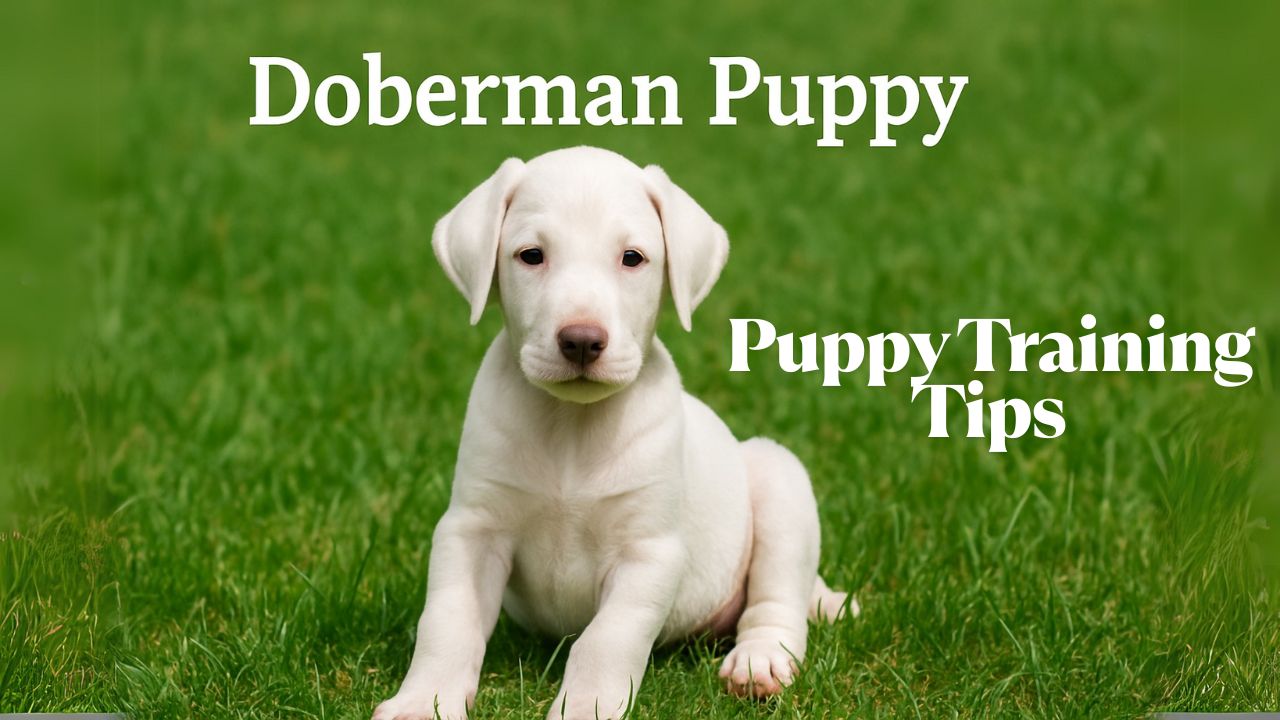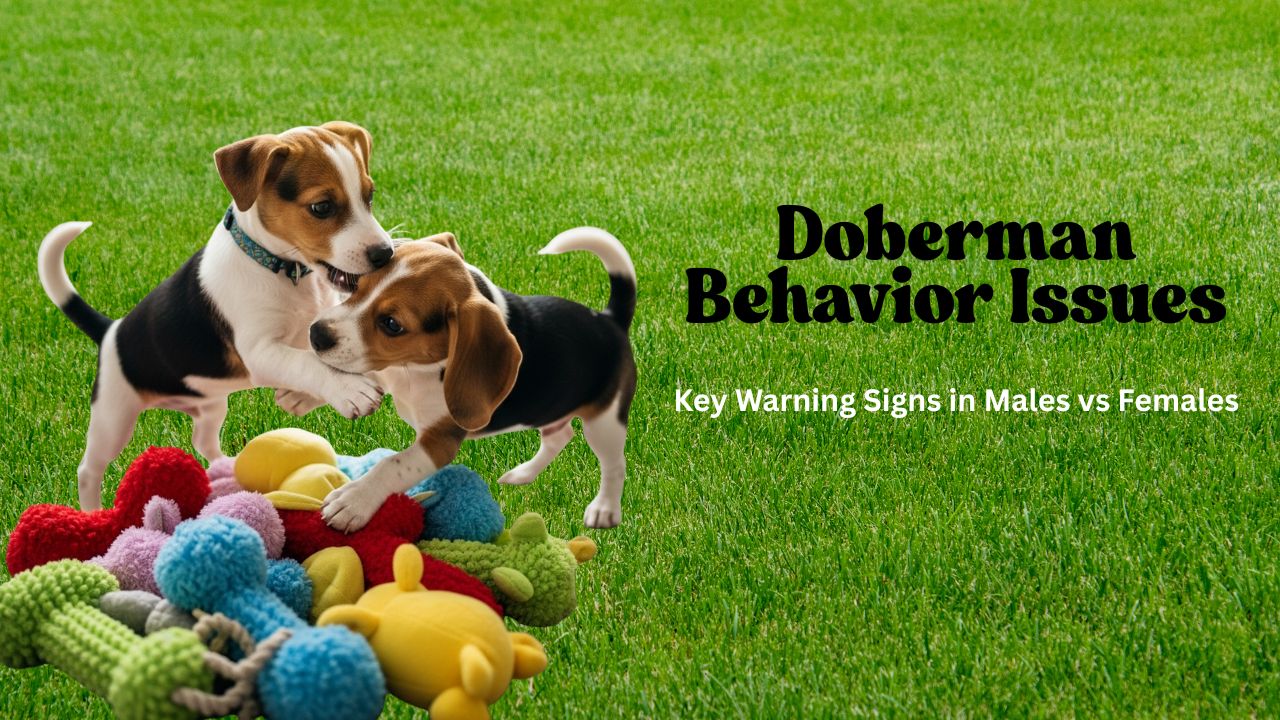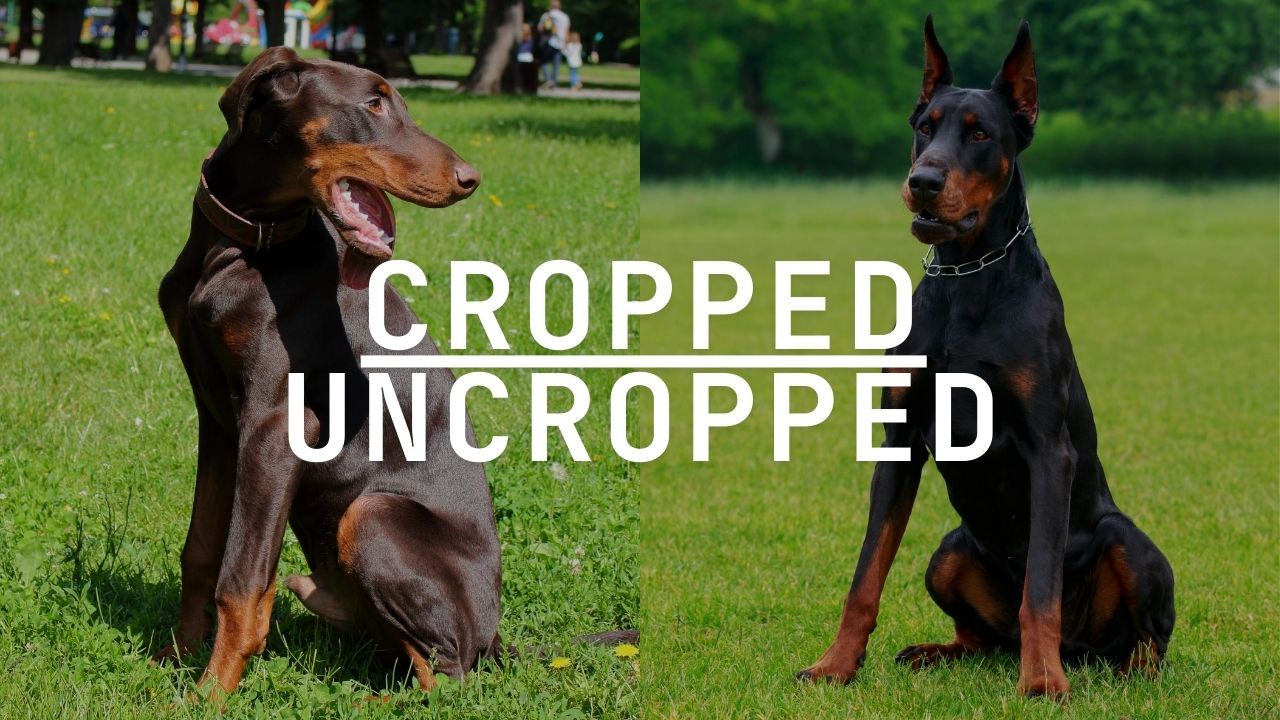Pedro Angel of Shaytan
30 days of Training in USA.
Price: $12,000
Quick Summary
- Training a Doberman puppy can be a rewarding journey when you start early and stay consistent.
- This guide covers 13 essential tips for first-time owners, from establishing routines and socialising your pup to teaching basic commands and preventing destructive behaviours.
Bringing a Doberman puppy into your life is exciting and overwhelming. These dogs are smart, loyal, and protective but also have a lot of energy and a strong personality. If you’re a first-time Doberman owner, you might be wondering how to start training a Doberman puppy. The truth is, raising a Doberman puppy can be challenging, but the rewards are totally worth it.
Training early is one of the best things you can do for your puppy and yourself. It’s not just about teaching commands or stopping unwanted behaviour—it’s about creating a connection based on trust and understanding. When you begin training from the start, your Doberman will grow up feeling secure and confident, and you’ll find it easier to guide them through life’s ups and downs. Early training helps prevent problems before they even start, making life smoother for both of you.
In this guide, we will be discussing 13 important tips on How To Train a Doberman Puppy, covering everything from setting up a routine to socialising your puppy and understanding their unique traits. With some patience and consistency, you’ll be on your way to raising a happy, well-behaved Doberman.
Start Training Early

The best time to start training your Doberman puppies is when you bring them home, usually around eight weeks old. Beginning early helps set the foundation for good habits that will last a lifetime. Puppies are like sponges at this age, soaking up everything around them, so it’s the perfect window to introduce basic commands and boundaries.
Consistency is absolutely crucial. Make sure everyone in the household is on the same page about the rules and follows them every day.
One of the doberman training tips include using positive reinforcement to encourage good behavior. Instead of focusing on what your puppy is doing wrong, reward them with praise, treats, or playtime when they get it right. This approach builds your puppy’s confidence and makes training a fun experience for both of you.
Establish a Routine
Dobermans thrive on routine. They’re intelligent dogs who feel more secure when they know what to expect each day. Establishing a consistent daily schedule is one of the best things you can do for doberman training.
Try to set regular times for feeding, potty breaks, playtime, and training sessions. When your puppy knows when it’s time to eat, go outside, or settle down, it helps them feel more in control of their environment and is a positive reinforcement for dobermans.
A predictable routine also makes it easier for your Doberman to learn house rules and build good habits. For example, scheduled potty training doberman puppies behave well in this regard—similarly, set training times to give your puppy a chance to focus and learn without being overwhelmed.
Consistency not only keeps your puppy calm and happy, but it also makes life easier for you as the owner. Over time, your Doberman will naturally start to follow the flow of your household, making training and daily life more enjoyable for everyone.
Socialise Your Puppy
Early socialisation is one of the most important parts of raising a well-rounded Doberman. These dogs are naturally alert and protective, so it’s crucial to introduce them to a variety of people, animals, and environments while they’re still young. This helps build their confidence and teaches them how to behave appropriately in different situations.
Start socializi doberman puppies by gently exposing your puppy to everyday sights and sounds like traffic, vacuum cleaners, or people wearing hats and sunglasses. Let them meet new people and interact with other friendly, vaccinated dogs in a safe, controlled way. These experiences teach your Doberman to prevent future issues like fear, anxiety, or aggression.
The doberman puppy training guide is another great option. They provide a structured environment where your pup can learn basic manners while getting used to being around other dogs and people.
The key is to make every new experience positive. Go slow, stay calm, and always reward your Doberman for handling new situations well.
Housebreaking and Crate Training
Housebreaking is one of the first significant challenges new puppy owners face. With a bit of consistency and patience, your Doberman will catch on quickly. The key is to stick to a regular potty schedule. Take your puppy out first thing in the morning, after meals, after playtime, and before bed. Puppies do best when they know what to expect, and a routine helps prevent accidents inside the house.
Thus, crate training doberman puppies can be a huge help during this stage. A crate gives your puppy a safe, quiet space to relax. It also speeds up the housebreaking process. Dogs naturally avoid going to the bathroom where they sleep, so using the crate wisely can teach your Doberman to hold it until it’s time to go outside.
The crate should never feel like a punishment. It’s not a time-out corner; it is your puppy’s den. Make it cosy with soft bedding and maybe a toy or two. Use treats and praise to help your Doberman associate the crate with positive feelings.
With the right approach, your puppy will start seeing the crate as a safe retreat and learn to do their business outside.
Teach Basic Commands

Once your Doberman puppy has settled into your home, it’s time to start with basic doberman training and commands. These are the building blocks of good behaviour and will make life with your pup much easier. Start with simple, essential cues like sit, stay, come, and leave it. These commands help keep your puppy safe and give you better control in everyday situations.
Use short, clear words for each command and stick to them. For example, don’t switch between saying “come” and “here”. Instead, choose one and use it every time. When your puppy follows a command correctly, reward them right away with a treat, praise, or playtime. This instant positive feedback helps them understand they did something right.
Keep training sessions short and fun, especially in the beginning. Puppies have short attention spans, so it’s better to practice for a few minutes a couple of times a day than to push them too long. With regular practice, your Doberman will start to pick up on these commands.
Leash Training
Leash training is an important step in helping your Doberman learn how to walk calmly by your side. Since Dobermans are strong and energetic, starting this early will make your walks much more enjoyable in the long run.
Begin the leash training doberman puppies by introducing the collar and leash gradually. Let your puppy wear the collar around the house for short periods so they get used to how it feels. Once they’re comfortable, clip on the leash and let them drag it around indoors under your supervision.
Start practising leash walking in a quiet, distraction-free space like your backyard or living room. Use treats and cheerful praise to encourage your puppy to stay close to your side without pulling ahead. If they start to tug, simply stop walking and wait until they return to your side before continuing.
Remember, leash training takes patience. Keep sessions short and positive at first, and gradually increase the difficulty by adding new environments and gentle distractions. With consistency and positive reinforcement, your Doberman will learn to walk on a leash with confidence and control.
Prevent Destructive Behaviors
Doberman puppies and doberman European puppies are naturally curious, and like all young dogs, they explore the world with their mouths. Chewing is a normal part of development, especially during teething.
To prevent destructive chewing, make sure your puppy has access to plenty of appropriate chew toys. Soft rubber toys, teething rings, or treat-dispensing toys are great options that keep their mouths busy and help soothe sore gums. Having the right toys around can make a big difference in steering your pup away from your furniture, shoes, or anything else they might find tempting.
If you catch your Doberman chewing on something they shouldn’t, don’t scold or punish them. Instead, calmly redirect their attention to a chew toy and praise them once they start using it. Over time, positive reinforcement for dobermans helps them learn which items are okay to chew and which are off-limits.
Address Barking and Whining
It’s normal for puppies to bark or whine, especially when trying to get your attention or adjusting to a new environment. But if it becomes excessive, it’s important to understand what’s behind the behavior so you can address it the right way and teach basic obedience for doberman puppies.
Start by figuring out the cause. Is your Doberman bored? Anxious? Hungry? In need of a potty break? Barking and whining are often a puppy’s way of communicating, and meeting their basic needs can help reduce the noise. Make sure your pup is getting enough physical exercise and mental stimulation throughout the day.
One common mistake is accidentally rewarding the behaviour. If your puppy learns that barking or whining brings attention, whether petting, eye contact or even scolding, they’re more likely to keep doing it. Instead, try to ignore the behaviour and only give attention when your puppy is calm and quiet. When they settle down, that’s the moment to praise or offer a treat.
Avoid Punitive Measures

When training your Doberman puppy, it’s essential to lead with patience and positivity. Using punishment or harsh corrections might seem like a quick fix, but it can actually do more harm than good. Dobermans are sensitive, intelligent dogs, and negative training methods can lead to fear, anxiety, or even aggression over time.
Instead of punishing your puppy for doing something wrong, focus on showing them what to do instead. Redirect Dobermans chewing unwanted stuff like shoes toward more appropriate actions. For example, offer a chew toy or ask for a “sit” instead of scolding. This is an important step in training doberman puppies to stop biting.
Positive reinforcement works wonders. When your Doberman does something right, reward them with praise, treats, or play. This teaches them that good behaviour gets good results and builds a stronger bond between you and your pup.
Consistency Across Family Members
Training a Doberman puppy is a team effort, especially if you live with family or roommates. To avoid confusing your puppy, it’s essential that everyone in the household follows the same rules and uses the same commands. If one person allows jumping on the couch while another doesn’t, your puppy won’t know what’s expected, which can slow down the training process.
Sit down as a family and agree on the house rules and training commands. For example, decide together whether “off” or “down” will be the cue to stop jumping, and make sure everyone sticks with it. This consistency helps to teach basic obedience for doberman puppies with less frustration.
It’s also a great idea to involve children in training sessions. Not only does it teach kids how to interact with the puppy respectfully, but it also builds trust and strengthens the bond between them. Just make sure young children are supervised and guided so training stays positive and safe for everyone.
Mental and Physical Exercise
Dobermans are high-energy dogs with sharp minds, so they need more than just a walk around the block to stay happy and well-behaved. Giving your puppy enough daily physical and mental exercise is essential for their overall health—and it can prevent a lot of common behaviour issues.
Start with physical activities like fetch, tug-of-war, or short agility exercises in the backyard. These not only help your Doberman burn off energy but also give you a chance to bond and practice basic commands in a fun way. As your puppy gets older, you can gradually increase the intensity and variety of physical exercise.
But don’t forget their brain. Dobermans are incredibly smart, and they love a challenge. Puzzle toys, treat-dispensing games, and regular training sessions are great ways to keep their minds busy. Even five to ten minutes of focused training each day can go a long way.
Remember, a tired puppy is a well-behaved puppy. When your Doberman gets the right balance of activity and mental stimulation, they’re far less likely to chew furniture or bark excessively.
Monitor Health and Nutrition
Taking care of your Doberman puppy’s health and nutrition is just as essential as training. Feeding a balanced diet suited to their age, size, and breed needs will give your puppy the energy and nutrients they need to grow strong and stay healthy.
Look for high-quality puppy food with the right mix of proteins, fats, and vitamins. Avoid feeding table scraps or foods that might upset their stomach. If you’re ever unsure about what to feed, your veterinarian can recommend the best options.
Speaking of vets, regular checkups are essential to keep an eye on your puppy’s development and catch any potential health issues early. Vaccinations, parasite prevention, and dental care are all part of a good health routine.
Proper nutrition supports not only your puppy’s physical growth but also their ability to focus during training and recover after play. When your Doberman is healthy and well-fed, they’ll have the stamina and mood to learn and thrive.
Seek Professional Help If Needed
Sometimes, despite your best efforts, training challenges can feel overwhelming. If you find that certain behaviours persist or you’re unsure how to handle a situation, don’t hesitate to seek professional help. Enrolling your Doberman puppy in obedience classes is a great way to get expert guidance tailored to your dog’s needs.
Professional trainers bring experience and tools that can make a big difference, especially with strong-willed breeds like Dobermans. They can help you understand your puppy’s behaviour, offer personalised training plans, and teach you effective techniques to handle tricky issues.
Conclusion
Raising a Doberman puppy can be both a challenging and incredibly rewarding experience, especially for first-time owners. Starting training early, establishing a consistent routine, and focusing on positive reinforcement are all essential steps in setting your puppy up for success.
Socialising your Doberman, teaching basic commands, and providing plenty of mental and physical exercise will help shape a confident, well-behaved companion. Don’t forget to pay attention to their health and nutrition, and seek professional help if you ever feel stuck.
Remember, patience and consistency are your best tools. Every puppy learns at their own pace, and the effort you put in now will pay off with a loyal, loving dog by your side for years to come.
If you’re ready to welcome a Doberman into your family or want expert advice on training your new puppy, European Doberman Breeder is here to support you every step of the way. Reach out today and take the first step toward building a strong, lifelong bond with your Doberman.
FAQs
When should I start training my Doberman puppy?
A.Start training as early as 8 weeks old to establish good habits and consistency from the beginning.
How important is socialisation for a Doberman puppy?
A.Socialization is crucial. Early exposure to different people, animals, and environments helps prevent fear and aggression later in life.
What are the basic commands I should teach first?
Begin with essential commands like sit, stay, come, and leave it. These build a foundation for more advanced training.
Potty training a Doberman puppy can feel overwhelming, especially for new dog owners. Dobermans are intelligent and eager to please, but like all puppies, they need guidance, patience, and consistency to develop good bathroom habits.
Successful Doberman puppy potty training keeps your home clean and sets the foundation for a well-behaved adult dog. In this guide, you’ll find actionable steps, practical tips, and solutions to common challenges, everything you need to housebreak your Doberman puppy confidently.
Have you tried potty training your Doberman yet? Share your experiences or questions in the comments below!
Why Potty Training Is Important for Doberman Puppies

Early potty training is crucial for Doberman puppies. Establishing good habits from the start helps prevent behavioural issues and makes life easier for both you and your puppy.
According to the American Society for the Prevention of Cruelty to Animals (ASPCA), dogs that are properly house-trained as puppies are up to 60% less likely to be surrendered to animal shelters due to behavioural issues later in life.
Housebreaking a Doberman teaches them where it’s appropriate to go, reduces indoor accidents, and strengthens the bond between you and your new companion.
Consistency and positive reinforcement are key to long-term success, ensuring your Doberman grows into a confident, well-mannered adult.
When to Start Potty Training a Doberman Puppy?
The best time to start Doberman training, including potty training, is as soon as you bring your puppy home, usually between 8 and 12 weeks of age. Getting an early start helps your pup adjust quickly to your household routines and expectations.
At this age, puppies are learning quickly but have limited bladder control, so expect frequent potty breaks. A consistent potty training schedule is essential for success.
Step-by-Step Guide to Potty Training a Doberman Puppy
Choose a Designated Potty Spot
Pick a specific location outside where you want your Doberman to go. Consistently taking your puppy to this spot helps them associate it with bathroom breaks.
Set a Regular Schedule
Puppies thrive on routine. Take your Doberman out:
- First thing in the morning
- After meals and drinking
- After naps or play sessions
- Before bedtime
- Every 1–2 hours during the day (for very young puppies)
Use Positive Reinforcement
Whenever your puppy goes in the right spot, immediately praise them enthusiastically and offer a treat. This reinforces the desired behaviour and speeds up learning.
Supervise and Watch for Cues
Keep a close eye on your puppy indoors. Signs they need to go include sniffing, circling, whining, or heading toward the door. If you notice these cues, take them outside right away.
Be Patient and Consistent
Potty training takes time and sometimes several weeks or even months. Stay consistent with your schedule and responses. Avoid punishing your puppy for accidents; instead, calmly clean up and try to prevent future mistakes.
Schedule Meals and Water
Feed your puppy at the same time each day. Predictable meal times help regulate when they need to go, making accidents less likely.
Common Challenges and How to Overcome Them
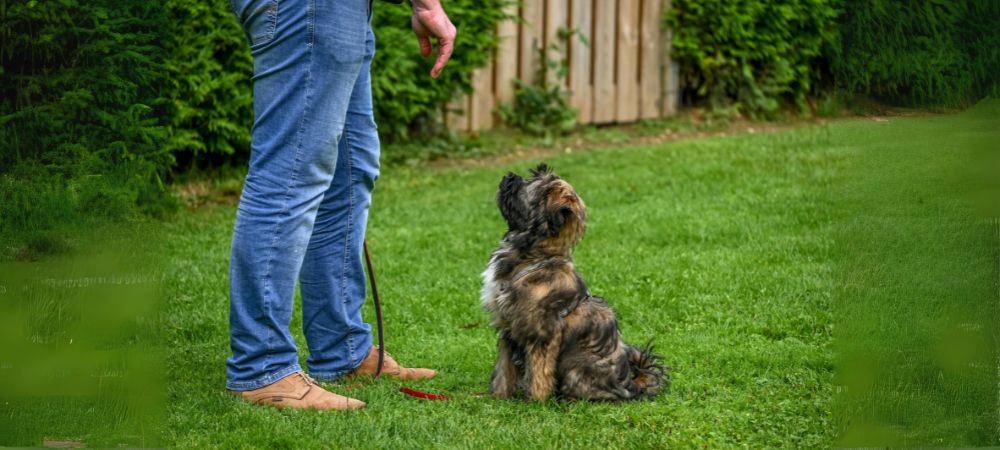
Accidents Indoors
If European Doberman puppies have an accident, it’s important to clean the area thoroughly with an enzymatic cleaner to remove odours. This helps prevent them from having accidents in the same spot again. Remember, accidents are a normal part of the training process.
Regression
Sometimes, puppies regress and have more accidents after making initial progress. Stay calm, reinforce your routine, and avoid punishment. Consistency will help your puppy get back on track.
Scheduling Issues
If you’re away from home for long periods, arrange for someone to let your puppy out. Puppies can only hold their bladder for about one hour per month of age.
Puppy Won’t Go Outside
If your puppy doesn’t go outside, limit distractions and give them about five minutes. If they don’t go, bring them back inside and try again later.
Using Crates and Leashes for Potty Training
Crate Training
A crate can be a powerful potty training tool. Puppies naturally avoid soiling their sleeping area. Use the crate for short periods when you can’t supervise your Doberman, and take them out immediately after crate time for a potty break.
Leash Training
Leashing your puppy during potty breaks keeps them focused on the task. You can also keep your puppy leashed to you indoors to quickly spot signs they need to go.
Signs Your Doberman Puppy Is Ready for Potty Training
Look for these signs that your Doberman puppy is ready to learn:
- Sniffing or circling
- Whining or pacing
- Heading toward the door
- Squatting suddenly indoors
If you notice these behaviours, take your puppy outside right away.
What to Do If Your Doberman Puppy Keeps Having Accidents
If accidents persist:
- Review your potty training schedule. Are you taking your puppy out often enough?
- Clean up thoroughly to remove all odours.
- Supervise more closely and use the crate when you can’t watch your puppy.
- Stay positive and patient—never punish your Doberman for accidents.
If you’re struggling, consider consulting a professional dog trainer who uses positive reinforcement methods for personalised Doberman potty training solutions.
Conclusion
Potty training a Doberman puppy takes patience, consistency, and plenty of positive reinforcement. Remember, every puppy learns at their own pace, and setbacks are normal. Stick to your routine, celebrate small victories, and soon your Doberman will be a housebroken, happy family member.
Ready to take the next step? Visit our Doberman Puppy Training section for more expert tips and support. Connect with a reputable European Doberman Breeder to find the perfect pup and get guidance from the start.
FAQs
When should I start potty training my Doberman puppy?
Begin potty training at 6–12 weeks old. Starting early helps build good habits while your puppy is most adaptable.
How often should I take my Doberman puppy outside?
Take your puppy out every 30–60 minutes, especially after eating, drinking, waking, or playing, to prevent accidents.
How should I reward my Doberman during potty training?
Use immediate praise and treats after successful potty trips to reinforce the behaviour.
What if my Doberman puppy has an accident indoors?
Stay calm and don’t punish. Clean with an enzymatic cleaner and stick to your potty schedule. Watch for signs they need to go out.
Born Date: 06/06/2025
Go Home: 08/03/2025
Sire: CH Devon Spalato Angel of Shaytan
Dam: CH J Lo of Incredible Diamonds
Red Female 1: Reserved
Red Female 2: Reserved
Black Female 3: Reserved
Black Female 4: Reserved
Red Male 1: Reserved
Red Male 2: Reserved
Black Male 3: Open
Black Male 4: Reserved
$5000
Litter Born: 05/25/2025
Go Home: 07/30/2025
Sire: CH Battito Della Andas
Black Female 1: Open
Black Female 2: Reserved
Red Female 3: Reserved
Red Female 4: Reserved
Black Male 1: Reserved
Black Male 2: Reserved
Red Male 3: Reserved
Red Male 4: Reserved
$5000
Due Date: 07/03/2025
Go Home: 09/05/2025
Sire: CH Anubis for Kolevski Grande Diamante
Dam: CH Harizma Angel of Shaytan
Black Female 1: Reserved
Black Female 2: Reserved
Red Female 3: Reserved
Red Female 4: Open
Black Male 1: Reserved
Black Male 2: Reserved
Red Male 3: Reserved
Red Male 4: Open
$5000
Understanding Doberman behavior issues is essential for current and prospective owners, especially when considering the differences between male and female Dobermans. While every dog is unique, general trends in temperament, aggression, dominance, and training challenges often vary by gender.
Recognizing these differences can help owners tailor their approach to training and socialisation, ensuring a well-adjusted, happy Doberman.
Have you noticed distinct behaviours in your male or female Doberman? Let’s explore the key behavioural differences and warning signs to watch for.
Doberman Behavior Issues – Warning Signs:
Physical and Temperamental Differences

Male Dobermans: Typically larger and more playful, male Dobermans tend to mature later, often around four years of age. Their youthful energy and social nature make them more tolerant of strangers and other animals.
Males usually bond with the entire family and are often more territorial, frequently marking their space.
Warning Signs in Males:
- Excessive marking or urine spraying indoors
- Overly boisterous or hyperactive behaviour
- Tolerance toward strangers suddenly turns suspicious or aggressive
- Persistent attention-seeking or demanding behaviour
Female Dobermans: Generally more reserved and quicker to mature, females often reach full maturity by two years old. They tend to form stronger bonds with one person and are more focused and intense.
Females are usually easier to train early on and may be more cautious or suspicious of strangers, while still being protective.
Warning Signs in Females:
- Excessive guarding or protective behavior toward one person.
- Avoidance or suspicion of new people or unfamiliar animals.
- Stubbornness or resistance during training if they feel threatened.
- Intense focus that can lead to anxiety or nervousness in chaotic settings.
Aggression and Dominance

Male Dobermans: Males often show stronger dominance and protective instincts. Their assertiveness and independence can make training more challenging, requiring firm, consistent leadership. Intact males are more prone to headstrong behavior, though neutering can help reduce aggression.
Warning Signs in Males:
- Challenging or resisting commands during doberman dog training,
- Growling, lunging, or snapping at other dogs or strangers.
- Excessive mounting or marking behaviors.
- Stiff body posture or intense staring is a dominance display.
Female Dobermans: Females are typically less aggressive but remain vigilant protectors. They respond well to positive reinforcement, are easier to train, and often direct their protective instincts toward a single person.
If you’re exploring the female Doberman Pinscher collection, you’ll notice many show this focused and attentive temperament, making them ideal for owners seeking a loyal, trainable companion.
Warning Signs in Females:
- Excessive barking or growling when strangers approach their owner
- Protective blocking or positioning between their person and others
- Resource guarding around food, toys, or resting areas
- Sudden mood changes or snap reactions when startled
Territorial Behavior
Male Dobermans: More likely to mark territory through frequent urination and may react strongly to unfamiliar people or animals. This behavior is a natural instinct to protect their home and family.
Warning Signs in Males:
- Frequent indoor urination or spraying on furniture, walls, or doorways
- Heightened alertness or agitation when visitors arrive
- Barking or lunging at neighbors, passersby, or other animals
- Pacing or restlessness near entry points like doors or windows
Female Dobermans: Less inclined to mark but often more suspicious of strangers. Their territorial behavior usually manifests as alertness and caution rather than marking.
Warning Signs in Females:
- Persistent watching or alert posture toward strangers
- Excessive barking at noises or unknown visitors
- Avoidance or defensive behavior in new environments
- Intense focus on perceived threats without physical aggression
Training and Socialization
Male Dobermans: Require consistent training and early socialization. Their playful, sometimes distracted nature means training should be firm yet engaging. Males may demand more attention and seek frequent interaction.
Warning Signs in Males:
- Difficulty focusing during training sessions
- Persistent jumping, mouthing, or play biting
- Overexcitement that leads to disobedience or distraction
- Lack of interest or fearfulness around new people or animals (if under-socialized)
Female Dobermans: Generally quicker learners with a stronger focus during training. They are eager to please but may become overly attached to their primary caregiver and less social if not properly exposed to varied experiences.
Warning Signs in Females:
- Reluctance or resistance when separated from their primary caregiver
- Fearful or shy behavior around unfamiliar people or dogs
- Stubbornness or selective hearing during training, if anxious
- Resource guarding or protective behaviors toward favored individuals
Health Considerations
Male Dobermans: More prone to prostate issues and other male-specific conditions, particularly if not neutered. Neutering can reduce aggression and dominance.
Warning Signs in Males:
- Difficulty urinating or signs of discomfort in the pelvic area
- Swelling or lumps near the genital region
- Behavioral changes such as increased aggression or lethargy
- Excessive marking or scent marking due to hormonal fluctuations
Female Dobermans: At risk for reproductive health problems such as pyometra and mammary tumors if not spayed. Spaying helps prevent these issues and may also moderate hormone-driven behavior changes.
Warning Signs in Females:
- Vaginal discharge, swelling, or discomfort during heat cycles
- Sudden lethargy, fever, or abdominal pain (possible pyometra)
- Lumps or masses around mammary glands
- Mood changes, irritability, or anxiety linked to hormonal fluctuations
Conclusion
Understanding the behavioral differences between male and female Dobermans helps owners anticipate challenges and tailor their training and socialization strategies. Patience, consistency, and positive reinforcement remain the cornerstones of successful Doberman training, regardless of gender.
Share your story or questions below, let’s support each other in raising confident, happy Dobermans! For expert advice and to find your perfect companion, connect with a reputable European Doberman Breeder today.
FAQs:
What are the main behavioral differences between male and female Dobermans?
Males are larger, more playful, territorial, and dominant, while females mature faster, are more reserved, easier to train, and often bond closely with one person.
Are male Dobermans more aggressive than females?
Males may show more dominance and aggression if not trained or neutered, while females are generally less aggressive but still protective. Training is important for both.
How does territorial behavior differ between males and females?
Males mark territory and react strongly to strangers; females are less likely to mark but are more cautious and alert around unfamiliar people.
What training challenges are common with male vs. female Dobermans?
Males can be playful and distracted, needing firm guidance; females learn faster and focus better, but may get overly attached. Early socialization and positive reinforcement help both.
Summary:
Doberman ear cropping is a long-debated cosmetic procedure rooted in tradition and aesthetics. While it gives a sharp, alert look, natural ears offer a gentler appearance. Health benefits of cropping are unproven, and ethical concerns are rising. The choice between cropped vs. uncropped ultimately depends on legal, cultural, and personal values.
The debate around Doberman ears cropped vs uncropped has stirred conversations among dog owners, breeders, and vets for years. While cropped ears give the Doberman a more alert, traditional look often seen in shows and protection work, uncropped ears offer a softer, natural appearance. But is one better than the other? This guide dives into the pros, cons, health implications, and ethical considerations of ear cropping that helps you decide what’s best for your Doberman.
Why Were Doberman Ears Cropped?

Ear cropping in Dobermans originated over a century ago, primarily for practical and protective reasons:
- Work and Protection: Dobermans were originally bred as guard dogs, police dogs, and personal protection dogs. In these roles, floppy ears were vulnerable to injury during fights or confrontations. Cropping removed the ear flap’s soft tissue, reducing the chance of an opponent grabbing or injuring the ears.
- Injury Prevention: Cropped ears were less likely to be torn or get caught on brush or fences, which was important for dogs working in rugged environments or in combat situations.
- Hygiene Beliefs: Historically, many breeders offering Doberman puppies for sale still follow traditional practices like ear cropping, especially in regions where it’s part of the breed standard. Modern veterinary science has largely disproven this, showing that proper ear care is far more important than ear shape in preventing infections.
- Breed Identity: Over time, the cropped ear look became synonymous with the Doberman breed’s identity, symbolizing alertness, strength, and fierceness.
Cropped vs. Uncropped Ears
| Feature | Cropped Ears | Uncropped (Natural) Ears |
| Appearance | Upright, pointed, “alert” look | Floppy, rounded, softer appearance |
| Breed Standard (AKC) | Cropped ears preferred in US show rings | Accepted but less common in US shows |
| Breed Standard (FCI/UK) | Natural ears preferred or required | Natural ears standard in many countries |
| Public Perception | Seen as traditional, formidable, or “tough” | Seen as gentle, approachable, or natural |
Cropped Ears
- Appearance:
Cropped ears are surgically altered to stand upright. This gives Dobermans a sharp, alert, and traditional look. The surgery removes part of the ear flap under anesthesia. After surgery, the ears are taped for weeks or even months to help them stand. There are different cropping styles—short, medium, and show crop—each with a different shape. - Breed Standards:
In the U.S., the American Kennel Club (AKC) accepts and prefers cropped ears in shows. Cropped ears are part of the Doberman’s traditional appearance. Many breeders and show enthusiasts follow this standard. Still, the AKC allows natural ears too. Uncropped Dobermans can compete and win, though they are less common in the show ring.
Uncropped (Natural) Ears
- Appearance:
Natural ears are soft, broad, and floppy. They give Dobermans a sweet, friendly, and more relaxed look. No surgery or special care is needed—just regular cleaning. - Breed Standards:
In many countries, cropping is banned. Kennel clubs like the FCI and the UK Kennel Club prefer natural ears. In these places, uncropped ears are the only accepted standard.
Ear Cropping in Dobermans: A Step-by-Step Guide
Ear cropping in Dobermans is a surgical procedure performed primarily for cosmetic reasons, aiming to create the breed’s iconic upright ear appearance. Here’s a detailed breakdown of each stage of the process:
Age for the Procedure
- Ideal Timing:
The procedure is typically performed on puppies between 7 to 12 weeks of age when the ear cartilage is still soft and pliable. This makes it easier to shape and train the ears to stand upright.
Pre-Surgical Evaluation
- Health Assessment:
Before surgery, a veterinarian conducts a thorough health evaluation, including a physical exam and possibly blood tests, to ensure the puppy is fit for anesthesia and surgery.
The Surgical Process
- Anesthesia:
The puppy is placed under general anesthesia to ensure the procedure is painless and safe. - Removal of Ear Tissue:
The veterinarian surgically removes a portion of the ear flap (pinna) according to the desired crop style—short, medium, or show crop. The goal is to create a shape that will stand erect once healed. - Suturing:
The cut edges of the ear are stitched carefully to promote proper healing and maintain the intended shape. - Duration:
The surgery itself typically takes about 30 minutes.
Aftercare and Recovery
- Initial Healing:
The ears are allowed to heal for about 10–14 days after surgery. Stitches are removed once healing has progressed well. - Taping and Bracing (Ear Posting):
Taping can last from several weeks to several months, depending on the crop style and the individual puppy. Consistency and patience during this period are crucial and can be supported by basic Doberman training that builds trust and cooperation. - Duration:
Posting can last from several weeks to several months, depending on the crop style and the individual puppy. For longer crops, it may take up to 6 months or even a year for the ears to stand permanently. - Monitoring:
Owners must closely monitor for signs of infection, irritation, swelling, or discharge. - Pain Management:
Veterinarians typically prescribe pain relief and antibiotics to manage discomfort and prevent infection. - Hygiene:
The ears must be kept clean and dry throughout the healing and posting period to reduce the risk of infection.
4. Pros and Cons of Cropping Doberman Ears
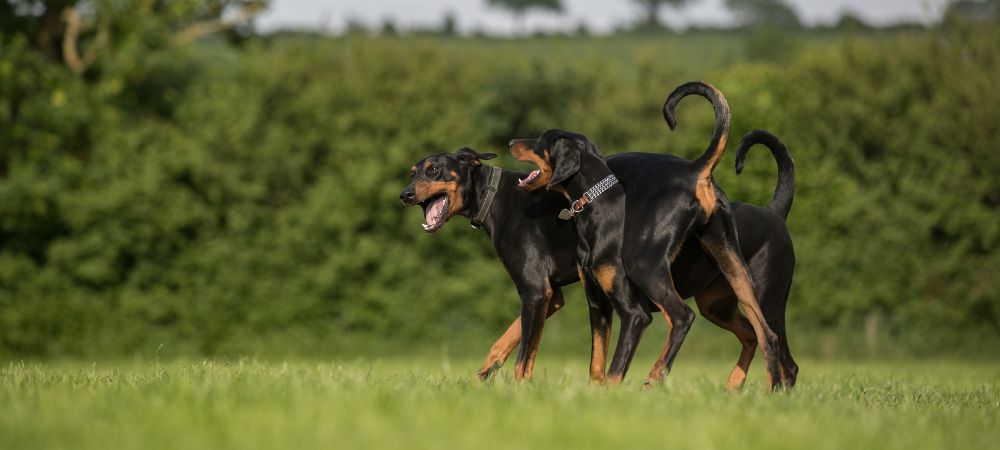
Pros
- Traditional Look: Cropped ears provide the Doberman with the iconic, alert, and formidable appearance many owners desire.
- Show Compliance: In the US and some other countries, cropped ears are often necessary for conformation shows.
- Historical Functionality: Originally, cropping reduced ear injury risk during work or combat.
Cons
- Pain and Stress: The procedure is painful and invasive, requiring anesthesia and a lengthy recovery.
- No Proven Health Benefit: There is no conclusive scientific evidence that cropping reduces ear infections or improves ear health.
- Ethical Concerns: Many veterinarians and animal welfare groups view cropping as an unnecessary cosmetic surgery that causes avoidable pain.
- Legal Restrictions: Ear cropping is banned or restricted in many countries due to animal welfare laws.
- Cost: The cost of ear cropping can vary, typically ranging from $300 to $600, depending on the veterinarian and location.
Legal and Ethical Considerations
Legal Status
- Banned or Restricted: Many European countries (including the UK, Germany, and France), Australia, and parts of Canada have banned ear cropping.
- Allowed with Restrictions: In the US, ear cropping is legal but controversial and regulated in some states.
- Breeders’ Compliance: Responsible breeders must adhere to their country’s laws and kennel club regulations.
Ethical Debate
- Animal Welfare: Opponents argue cropping is a painful, unnecessary procedure done solely for human aesthetics.
- Veterinary Stance: The American Veterinary Medical Association (AVMA) and many other veterinary bodies oppose cosmetic ear cropping.
- Cultural Tradition: Supporters cite breed tradition and owner choice, but this is increasingly challenged by modern animal welfare perspectives.
Health Implications of Cropping vs. Natural Ears
Ear Infection Risks
- Cropped Ears: Some believe cropping improves airflow and reduces infections, but studies show no significant difference. Proper ear hygiene is key.
- Natural Ears: Floppy ears can trap moisture and debris, potentially increasing infection risk, but regular cleaning mitigates this.
Behavior and Communication
- No Impact on Temperament: Cropping does not affect a Doberman’s personality, intelligence, or behavior.
- Communication: Dogs use ears for body language; cropping may slightly alter visual signals but does not impair communication significantly.
Doberman Ear Care: Cropped vs. Natural

Cropped Ears
- Post-Surgery Care: Intensive care is needed during healing—taping, cleaning, and monitoring.
- Long-Term Care: Cropped ears require less routine cleaning but must be checked regularly for infections or injuries.
Natural Ears
- Routine Cleaning: Floppy ears need regular cleaning to prevent wax buildup and infections.
- Inspection: Owners should watch for signs of redness, odor, or discomfort indicating infection.
Conclusion:
Whether you decide on cropped or natural ears, what truly matters is your Doberman’s health, happiness, and overall care. Cropped ears offer a bold, traditional look, while natural ears reflect a softer and more modern approach; both are valid choices depending on your values and lifestyle. With no proven health benefits to cropping and increasing ethical awareness, many new owners are now embracing the natural look.
Looking for a loyal, well-bred Doberman to join your family? Connect with a trusted European Doberman breeder offering health-tested puppies and expert guidance on raising a confident, well-trained companion.
FAQs:
Does ear cropping affect a Doberman’s behavior or personality?
No, ear cropping is purely cosmetic and has no impact on a Doberman’s temperament, intelligence, or behavior. Whether cropped or natural, a Doberman’s personality remains the same.
Is ear cropping painful for the dog?
Yes, ear cropping is a surgical procedure that involves pain and a recovery period. Though performed under anesthesia, the healing and aftercare can be uncomfortable and stressful for the puppy.
Is ear cropping illegal?
Ear cropping is banned or restricted in many countries, including the UK, Australia, parts of Europe and Canada. In the U.S., it’s legal but controversial and regulated in some states.
Do uncropped Dobermans get more ear infections?
Not necessarily. While some believe floppy ears trap more moisture, studies show no major difference in infection rates. Regular ear cleaning is more important than whether the ears are cropped or not.
Summary:
The Doberman Pinscher is a striking combination of loyalty, intelligence, and elegance. Known for their exceptional trainability, natural protectiveness, and deep affection for their families. They require minimal grooming, thrive on physical and mental challenges, and form strong emotional bonds with their owners. If you’re seeking a devoted, alert, and energetic partner for life, consider connecting with a European Doberman Breeder to welcome this incredible breed into your home.
The Doberman Pinscher: The very name evokes images of sleek power, unwavering loyalty, and unmatched intelligence. These dogs are more than just striking in appearance; they are deeply devoted companions, exceptional protectors, and remarkably versatile partners. If you’re on the fence about bringing one of these incredible animals into your life, let’s explore seven compelling reasons why a Doberman Pinscher might just be the perfect addition to your family.
1. Unleash Their Genius: Exceptional Intelligence and Trainability

Imagine a dog so intelligent it anticipates your commands before you even utter them. Dobermans aren’t just smart, they possess a level of cognitive ability that sets them apart. Ranked consistently among the most intelligent dog breeds, they absorb training like a sponge, mastering complex commands and tasks with impressive speed.
This isn’t just about teaching tricks; it’s about forging a deep, intellectual connection with your dog. Their eagerness to please, combined with their quick wit, transforms training into a rewarding experience. Whether you’re aiming for advanced obedience, dazzling agility performances, or even specialized protection work, the Doberman’s sharp mind will astound you.
Forget endless repetition and frustrating setbacks. With a Doberman, you’ll be amazed at how quickly they grasp new concepts, making training a joy rather than a chore.
2. Loyalty Beyond Measure: An Unwavering Protector by Your Side
In a world where true loyalty can be hard to find, the Doberman stands as a beacon of unwavering devotion. Their protective instincts are legendary, and they form incredibly strong bonds with their families.
This isn’t just about guarding your property; it’s about a deep-seated desire to keep those they love safe from harm. With proper socialization and training, that innate protectiveness transforms into a responsible, reliable guardian, providing an unparalleled sense of security and peace of mind.
According to a large community survey, Dobermans are highly trainable, respond best to positive reinforcement, and thrive in environments where they can exercise and engage actively, which supports their role as dependable protectors
3. A Heart of Gold: The Doberman as a Loving Family Member
Don’t let their imposing physique fool you; beneath that confident exterior lies a heart brimming with affection. Dobermans are incredibly loving and gentle with their families, often forming especially strong bonds with children.
They are playful companions, always up for a game, a cuddle on the couch, or a comforting presence during tough times. Early socialization is key to ensuring they learn to channel their energy appropriately and develop a gentle demeanor towards all family members, big and small.
Dispel the myth of the aggressive Doberman. When raised in a loving home with consistent training, they blossom into devoted family members, showering their loved ones with affection and unwavering companionship.
4. Effortless Elegance: Minimal Grooming, Maximum Impact
If you’re seeking a dog that exudes sophistication without demanding hours of pampering, the Doberman is your answer. Their short, sleek coat requires surprisingly little maintenance.
A weekly brushing is typically all it takes to keep their coat gleaming and their skin healthy. This is a breed that proves less is more, allowing you to spend less time on grooming and more time enjoying their company.
Imagine a dog that always looks impeccably groomed with minimal effort. The Doberman’s low-maintenance coat allows you to appreciate their natural beauty without the hassle of constant grooming appointments.
5. Born to Move: Versatile and Energetic Companions for Active Lifestyles
Dobermans are athletic powerhouses, brimming with energy and enthusiasm for physical activity. They’re not content to be couch potatoes; they thrive on challenges and excel in a variety of canine sports and activities.
Whether you’re a seasoned marathon runner, a weekend hiker, or simply enjoy a brisk daily walk, the Doberman will be your enthusiastic and tireless partner. From agility courses to Schutzhund training, their versatility knows no bounds.
Say goodbye to sedentary weekends. A Doberman will motivate you to get active, explore the outdoors, and embrace a healthier, more energetic lifestyle.
6. The Silent Guardian: An Alert and Watchful Presence

Dobermans possess an innate awareness of their surroundings, making them exceptional watchdogs. They are constantly vigilant, keenly observing their environment and readily alerting their owners to any unusual sounds or activity.
This isn’t about aggression, it’s about a natural protective instinct that provides an invaluable sense of security.
Rest easy knowing your home is under the watchful gaze of a Doberman. Their alertness and discerning nature will deter potential threats and provide you with peace of mind.
7. Built to Last: A Relatively Healthy Breed with a Commitment to Responsible Breeding
If you’re considering bringing a Doberman into your home, look for reputable Doberman puppies for sale from responsible breeders who prioritize health testing and genetic screening. This ensures that you’re adopting a puppy that has the potential for a long, healthy life with your family.
With proper care, a nutritious diet, and regular veterinary checkups, Dobermans can enjoy a lifespan of 10–12 years, providing years of unwavering companionship.
Invest in a dog that’s built to thrive. Responsible breeding practices have significantly improved the health and longevity of Dobermans, ensuring you’ll have many years of joy with your loyal companion.
Important Considerations Before Welcoming a Doberman
While the Doberman’s qualities are undeniably compelling, it’s crucial to consider the commitment required to raise a happy, well-adjusted dog:
- Exercise and Mental Stimulation: Dobermans are intelligent and high-energy dogs, requiring ample daily exercise and mental challenges to prevent boredom and destructive behaviors.
- Socialization and Training: Whether you choose to adopt Doberman puppies or get them from a breeder, early socialization is key to raising a well-behaved dog. Adopting a Doberman puppy from a shelter or rescue gives you the joy of knowing you’re providing a loving home to a dog in need.
- Experienced Owners Preferred: Dobermans are not always the best choice for first-time dog owners due to their strong personalities and need for consistent leadership.
Conclusion:
Choosing a Doberman Pinscher means embracing a life filled with loyalty, intelligence, protection, and boundless energy. These dogs aren’t just pets; they’re partners in every sense of the word. From their stunning appearance to their razor-sharp minds, Dobermans are built for those who seek more than just companionship; they seek a bond rooted in trust, respect, and love. Whether you’re looking for a family guardian, an adventure buddy, or a loyal shadow who understands you like no other, the Doberman delivers it all with elegance and heart.
Dobermans require consistent training, early socialization, and daily physical and mental challenges to flourish.
Ready to welcome this majestic breed into your home? Connect with a trusted European Doberman Breeder and take the first step toward lifelong companionship with one of the world’s most intelligent and loyal dogs.
FAQs:
Are Dobermans good with children and families?
Yes, when properly socialized from a young age, Dobermans are affectionate, gentle, and form strong bonds with children and family members.
How much exercise does a Doberman need?
Dobermans require at least 1–2 hours of daily physical and mental activity to stay happy, healthy, and well-behaved.
Are Dobermans aggressive?
No. While protective by nature, a well-trained and socialized Doberman is not aggressive but instead confident, alert, and loyal.
Do Dobermans require a lot of grooming?
Not at all! Their short, sleek coats are low-maintenance and only need occasional brushing to stay clean and shiny.
Where can I find a trusted Doberman breeder?
To ensure health and temperament, look for a European Doberman Breeder who follows responsible breeding practices and provides health testing documentation.


